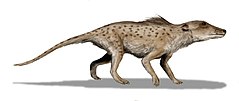Cetartiodactyla
Z Wikipedii, wolnej encyklopedii
Cetartiodactyla – rząd ssaków łożyskowych, który został utworzony w wyniku najnowszych badań genetycznych i molekularnych gromady ssaków. Grupa ta nie ma aktualnie nazwy w języku polskim.
| Cetartiodactyla | |||
| Montgelard, Catzeflis & Douzery, 1997 | |||
 Przedstawiciel rzędu – prawaleń Pakicetus inachus | |||
| Systematyka | |||
| Domena | |||
|---|---|---|---|
| Królestwo | |||
| Typ | |||
| Podtyp | |||
| Gromada | |||
| Podgromada | |||
| Infragromada | |||
| Nadrząd | |||
| Rząd |
Cetartiodactyla | ||
| Podrzędy | |||
| |||

Taksonomia
Podsumowanie
Perspektywa
W wyniku przeprowadzonych badań okazuje się, że hipopotamowate są daleko spokrewnione ze świniowatymi i tym samym nie należą do świniokształtnych. Za najbliższych natomiast krewnych Whippomorpha uważa się przeżuwacze (np. krowy i owce), z którymi tworzą Cetruminantia. Ta zaś grupa wraz ze wspomnianymi wcześniej świniowatymi należy do Artiofabula. Tylopody (wielbłądy i ich wymarli krewni) okazały się na tyle specyficzne molekularnie, genetycznie jak i morfologicznie, iż zaliczono je bezpośrednio do Cetartiodactyla.
Boisserie i in. (2005) przebadali dla potwierdzenia powyższej tezy szczątki większości wymarłych znanych ssaków kopytnych i waleni. Wśród wymienionych tu rodzin i rzędów zauważyli 80 charakterystycznych cech, dzięki którym można wprowadzić taki podział ssaków.
Podział systematyczny
Klasyfikacja dla rodzin występujących współcześnie za Illustrated Checklist of the Mammals of the World[1][2]:
- podrząd: Whippomorpha Waddell, Okada & Hasegawa, 1999
- infrarząd: Cetacea Brisson, 1762 – walenie
- parvordo: Mysticeti Flower, 1864 – fiszbinowce
- rodzina: Balaenidae J.E. Gray, 1821 – walowate
- rodzina: Neobalaenidae G.S. Miller, 1923 – walenikowate
- rodzina: Balaenopteridae G.S. Miller, 1923 – płetwalowate
- parvordo: Odontoceti Flower, 1867 – zębowce
- nadrodzina: Physteroidea J.E. Gray, 1821
- rodzina: Physeteridae J.E. Gray, 1821 – kaszalotowate
- rodzina: Kogiidae Gill, 1871 – kogiowate
- nadrodzina: Ziphioidea J.E. Gray, 1865
- rodzina: Ziphiidae J.E. Gray, 1865 – zyfiowate
- nadrodzina: Platanistoidea J.E. Gray, 1846
- rodzina: Platanistidae J.E. Gray, 1846 – suzowate
- nadrodzina: Lipotoidea Zhou, Qian & Li, 1978
- rodzina: Lipotidae Zhou, Qian & Li, 1978
- nadrodzina: Inioidea J.E. Gray, 1846
- rodzina: Iniidae J.E. Gray, 1846 – iniowate
- rodzina: Pontoporiidae J.E. Gray, 1870
- nadrodzina: Delphinoidea J.E. Gray, 1821
- rodzina: Monodontidae J.E. Gray, 1821 – narwalowate
- rodzina: Delphinidae J.E. Gray, 1821 – delfinowate
- rodzina: Phocoenidae J.E. Gray, 1825 – morświnowate
- parvordo: Mysticeti Flower, 1864 – fiszbinowce
- infrarząd: Ancodonta Matthew, 1929
- rodzina: Hippopotamidae J.E. Gray, 1821 – hipopotamowate
- infrarząd: Cetacea Brisson, 1762 – walenie
- podrząd: Ruminantia Scopoli, 1777 – przeżuwacze
- infrarząd: Tragulina Flower, 1883
- rodzina: Tragulidae Milne-Edwards, 1864 – kanczylowate
- infrarząd: Pecora Flower, 1883
- rodzina: Antilocapridae J.E. Gray, 1866 – widłorogowate
- rodzina: Giraffidae J.E. Gray, 1821 – żyrafowate
- rodzina: Cervidae Goldfuss, 1820 – jeleniowate
- rodzina: Moschidae J.E. Gray, 1821 – piżmowcowate
- rodzina: Bovidae J.E. Gray, 1821 – wołowate
- infrarząd: Tragulina Flower, 1883
- podrząd: Suina J.E. Gray, 1868 – świniokształtne
- rodzina: Suidae J.E. Gray, 1821 – świniowate
- rodzina: Tayassuidae Palmer, 1897 – pekariowate
- podrząd: Tylopoda Illiger, 1811 – wielbłądokształtne
- rodzina: Camelidae J.E. Gray, 1821 – wielbłądowate
Przypisy
Bibliografia
Wikiwand - on
Seamless Wikipedia browsing. On steroids.
